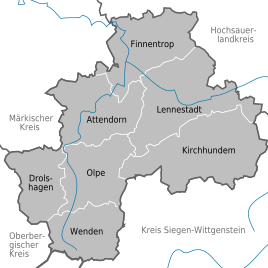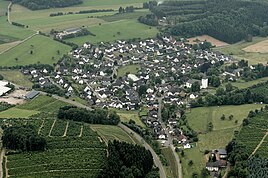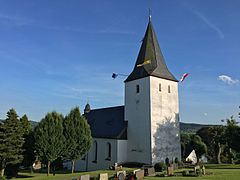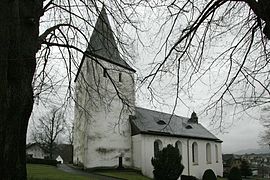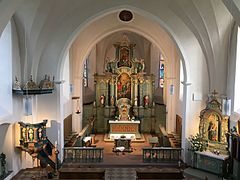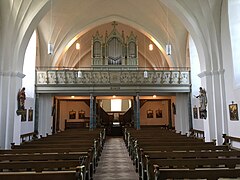Schönholthausen
|
Schönholthausen
Finnentrop municipality
|
||
|---|---|---|
| Coordinates: 51 ° 11 ′ 27 ″ N , 8 ° 0 ′ 22 ″ E | ||
| Height : | 305 m above sea level NHN | |
| Residents : | 731 (December 31, 2018) | |
| Incorporation : | 1st July 1969 | |
| Postal code : | 57413 | |
| Area code : | 02721 | |
|
Location of Schönholthausen in the Olpe district |
||
|
Aerial photograph (2014)
|
||
Schönholthausen is a village in the Olpe district , in the southern Sauerland , in South Westphalia , around five kilometers south of the upper basin of the Rönkhausen pumped storage plant . The place has around 750 inhabitants and belongs to the political municipality of Finnentrop . The north-western part of the village is still in the Sauerland-Rothaargebirge Nature Park . The SauerlandRadring , which runs along part of the route of the former Finnentrop – Wennemen railway line , runs along near Schönholthausen .
history
Schönholthausen was first mentioned in 1240. What is certain is that Herford Abbey had its own church on the site of today's Schönholthausen church as early as the 11th century, possibly even before the turn of the millennium. This church belonged to the office of Schönholthausen , to which the monastery had grouped a large number of farms outside of what is now the municipality of Finnentrop.
The dues of this farm association were collected in Schönholthausen and brought to Herford. Every three years the abbess of the monastery resided in Schönholthausen to inspect the property of the office. From this first stone church, remains of the foundations of the apse and a pillar were found during excavations in 1978 .
In the course of the 13th century, a layer of the lower nobility formed in the surrounding areas , who settled on manors, and Schönholthausen also became the seat of a knight family.
From the middle of the 15th century, the area of Schönholthausen belonged to the Duchy of Westphalia of the Archbishops of Cologne . From an administrative point of view, Schönholthausen belonged together with Rönkhausen and Lenhausen to the Cologne office of Waldenburg . As a court, the Gogericht in Attendorn was responsible for the place.
Early clues about the size of Schönholthausen can be found in an appraisal register (used to collect taxes) from 1543. According to this, there were 16 treasurers in “Schönholtzhausen Baurschektiven” at that time. The number of those liable for the treasury is likely to have roughly matched the existing families or houses.
After the Reichsdeputationshauptschluss 1806 Schönholthausen came into the Grand Duchy of Hesse , the district of the Attendorn Justice Office. After the Congress of Vienna , Schönholthausen and most of the former Duchy of Westphalia fell to Prussia in 1815 . In 1817 the Attendorn Justice Office lost its administrative function, but jurisdiction remained with him.
From 1817 the administration of Schönholthausen was initially subordinate to the Bilstein district . But on January 1, 1819, it was incorporated into the Eslohe district , which became the Meschede district from 1832 . Schönholthausen remained in this district until 1969. By the Westphalian rural community order of 1841, Schönholthausen was confirmed as an independent municipality on October 5, 1843. Until then it had belonged to the mayor's office in Serkenrode , which has now been renamed to Amt Serkenrode and, in addition to Schönholthausen, included the communities Schliprüthen and Oedingen .
On January 1, 1832, the new community Wildewiese was formed by outsourcing from Schönholthausen. The rural community Schönholthausen included u. a. the districts of Fretter, Ostentrop, Bamenohl, Habbecke, Lenhausen and Weringhausen. With an area of 6,465 hectares, the community had 3,450 predominantly Catholic inhabitants in 1895, 4,807 inhabitants in 1910 and 7,589 inhabitants in 1939.
During the local reorganization on July 1, 1969, Schönholthausen and Schliprüthen were combined to form the new community of Finnentrop.
church
In Schönholthausen is the Catholic Church of the parish of the Assumption of Mary Schönholthausen . This church was in the 13th century parish church of its own parish .
The church in its current form represents the third church building. Of the first stone church, which must have stood here as early as the 11th century, only remains of the foundations could be found during excavations in 1978.
From the second church building, a three-aisled Romanesque church from the 13th century, the steeple still stands today. The wooden belfry still preserved in the tower, however, dates from the 17th century. At the latest since 1734, when a repair is guaranteed, the church tower also had a clock. Today's church tower clock from the tower clock factory JF Weule dates from 1900. Three of the four bells in the church tower were confiscated and melted down in 1917 during the First World War , the fourth and three bells added in 1924 were then melted down in 1942 during the Second World War . All that remained was a small bell, cast in 1716, the so-called "transformation bell", which is still in use today. In 1949 four church bells were cast again for the four-bell set. From the second church building, the pulpit, whose basket is decorated with pine cones - symbols of life - instead of the four evangelists, two side altars, two confessionals, choir pews, a series of figures and pictures were taken from the second church building. The altar is a high altar that comes from the parish church of St. Cyriakus in Berghausen (Schmallenberg) . The pulpit is from 1686.
When the third church was built, the current nave with choir was built between 1733 and 1736. It is a baroque style hall , which also has Gothic elements. Today's organ stage was built between 1791 and 1794. Today's organ dates from 1902 and was manufactured by the Stockmann brothers' organ building company in Werl . The four medallions with the church fathers Gregorius , Hieronymus , Augustinus and Ambrosius in the choir are still preserved from a painting of the church from 1878 by the painter Anton Goldkuhle, who can be attributed to the Wiedenbrück school . Today's church windows also date from this time. In 2012 the interior of the parish church was extensively restored.
Education and museums
The Schönholthausen Catholic Primary School, whose predecessor schools have existed since 1647, can be found in Schönholthausen. The Kindergarten Zwergenland in the neighboring town of Ostentrop is run by the joint Kindergarten Parents Association Ostentrop / Schönholthausen e. V. operated.
In Schönholthausen is the museum "Heimatstube" Schönholthausen , a museum run by the Heimatverein Schönholthausen e. V. supported local history museum . The focus of the exhibition is agriculture, forestry and housekeeping, handicrafts in the village and wedding customs. In the museum there is also a classroom from 1920 and an old doctor's office.
Club life
In the musical field, Schönholthausen has a music association, a marching band, the MGV Sängerbund 1850 Schönholthausen and the women's choir Fun & Joy Ostentrop-Schönholthausen , as well as the young choir in Schönholthausen-Ostentrop.
In the sporting field, the Rot-Weiß 1927 Ostentrop-Schönholthausen e. V. The Schützenbruderschaft St. Sebastianus Schönholthausen-Ostentrop 1818 e. V. celebrates the traditional shooting festival on the last weekend in June every year . There is also the Sauerländer Freizeitkutscher e. V. , with the aim of exploring the Sauerland mountains on route and orientation trips with the involvement of the whole family.
coat of arms
The coat of arms of Schönholthausen has a golden background, which is crossed by a red bar from top left to bottom right. An oak branch with an acorn can be seen at the top right and bottom left . The sloping red bar in gold is taken from the coat of arms of the von Schnellenberg zu Schönholthausen family, who had owned a manor as a fiefdom of the Archbishops of Cologne since the 13th century. The two oak leaves are a reference to the place name component "holt" from Schönholthausen, which means "wood = forest".
Important people from Schönholthausen
- Bishop Johann Friedrich Adolf von Hörde (* December 5, 1688 in Schönholthausen; † August 3, 1761 ), Apostolic Vicar of the North (since 1722), first titular bishop of Flaviopolis (since 1723), Auxiliary Bishop of Osnabrück (since 1723)
- Merchant Heinrich Weke, founder of Ewig Monastery and Ewig Hospital, * towards the end of the 14th century
- Anton Kayser, parish leader and member of parliament, * March 8, 1792, † December 25, 1861
- Franz Beckmann, a scientist from Schönholthausen, born April 10, 1810, † August 27, 1868
- Franz Kayser, a pioneer in Raiffeisen , born June 7, 1834, † May 16, 1927
- Bernhard Melcher, farmer and mayor, * March 7, 1903, † March 10, 1981
- Albert Deimel, inventor of the peeler (patent dated February 14, 1936)
See also
literature
- Volker Kennemann (Red.): Schönholthausen. An old parish village in the Sauerland region of Cologne . Finnentrop 1990.
- Wilhelm Voss: Office Waldenburg / Parish Schönholthausen - courtyards in the parish of Schönholthausen . Schönholthausen 1940 ( heimatbund-finnentrop.de [PDF]).
Web links
- Schönholthausen in the Westphalia Cultural Atlas
Individual evidence
- ↑ Population statistics of the municipality of Finnentrop (as of December 31, 2018). (PDF) Municipality of Finnentrop, accessed on June 13, 2019 .
- ↑ Federal Agency for Nature Conservation: Homert Nature Reserve (Geodienst Protected Areas)
- ↑ Railway documents Finnentrop – Wennemen ( Memento of the original from January 5, 2014 in the Internet Archive ) Info: The archive link was inserted automatically and has not yet been checked. Please check the original and archive link according to the instructions and then remove this notice.
- ↑ Archived copy ( memento of the original from October 3, 2011 in the Internet Archive ) Info: The archive link was inserted automatically and has not yet been checked. Please check the original and archive link according to the instructions and then remove this notice. Page 76
- ↑ Stephanie Reekers: The regional development of the districts and communities of Westphalia 1817-1967 . Aschendorff, Münster Westfalen 1977, ISBN 3-402-05875-8 , p. 296 .
- ↑ Martin Bünermann: The communities of the first reorganization program in North Rhine-Westphalia . Deutscher Gemeindeverlag, Cologne 1970, p. 89 .
- ↑ Historical information about the parish of Schönholthausen ( Memento of the original from April 1, 2012 in the Internet Archive ) Info: The archive link has been inserted automatically and has not yet been checked. Please check the original and archive link according to the instructions and then remove this notice. Issue 1, accessed on January 2, 2014 (PDF; 1.2 MB)
- ↑ Historical information about the parish of Schönholthausen ( Memento of the original from September 24, 2015 in the Internet Archive ) Info: The archive link was inserted automatically and has not yet been checked. Please check the original and archive link according to the instructions and then remove this notice. Issue 2, accessed on January 2, 2014 (PDF; 7.27 MB)
- ↑ Partner for School NRW Bullerbü in the Sauerland ( Memento of the original from January 5, 2014 in the Internet Archive ) Info: The archive link was inserted automatically and has not yet been checked. Please check the original and archive link according to the instructions and then remove this notice.
- ↑ Museum landscape in the Olpe district: The Schönholthausen home parlor
- ↑ Explore home by horse-drawn carriage.

